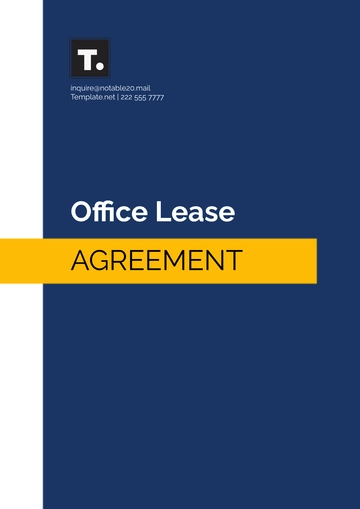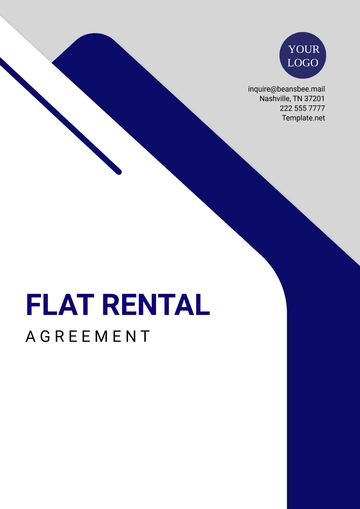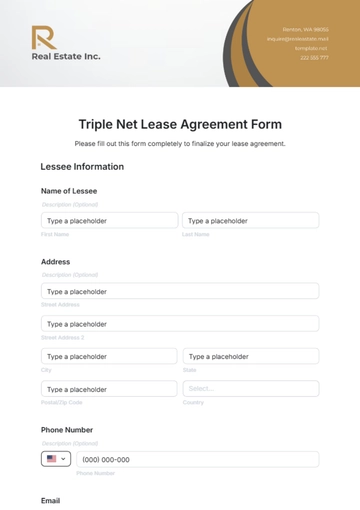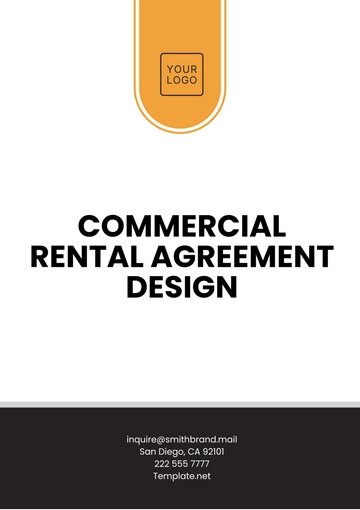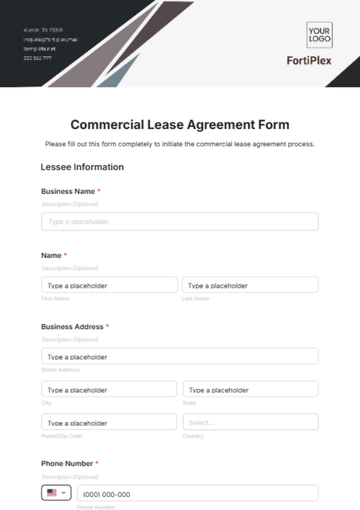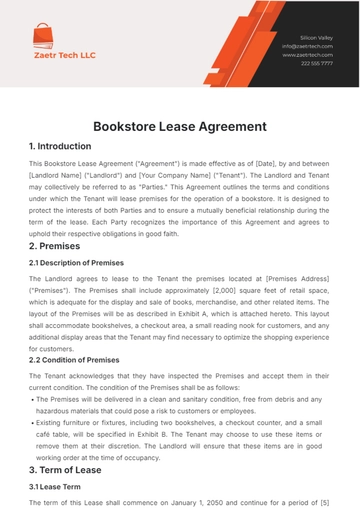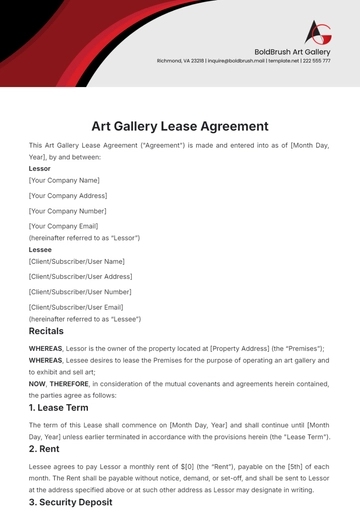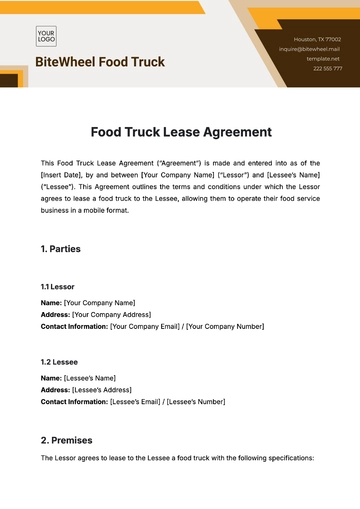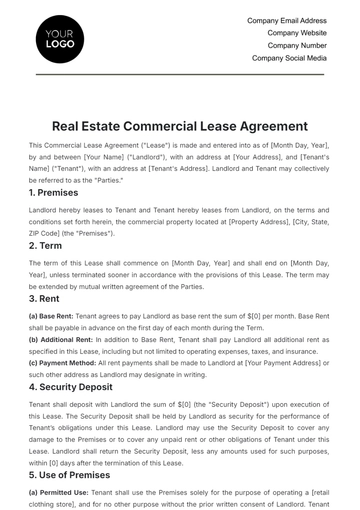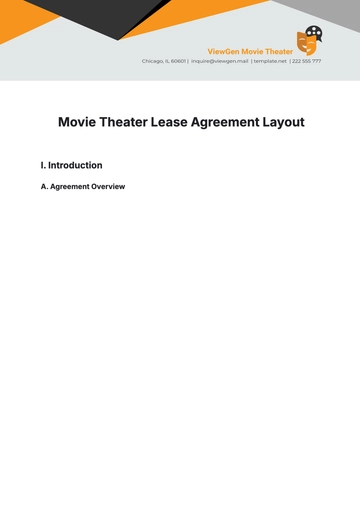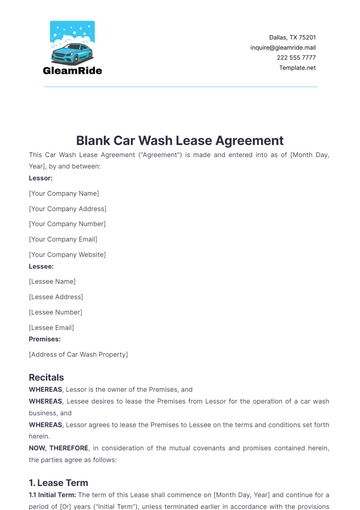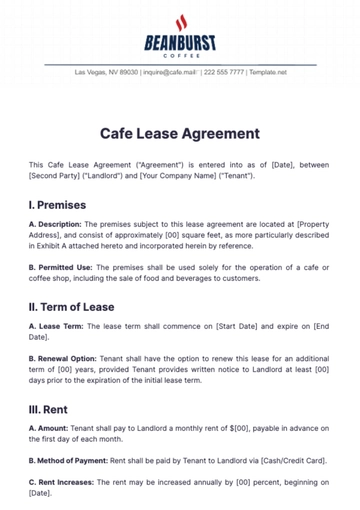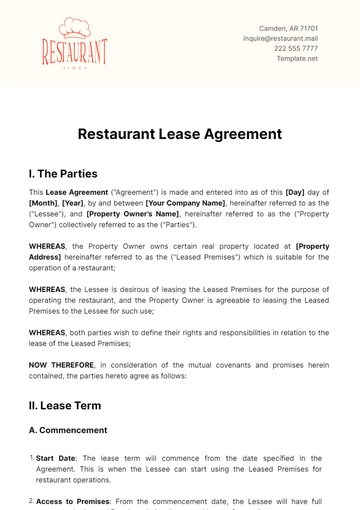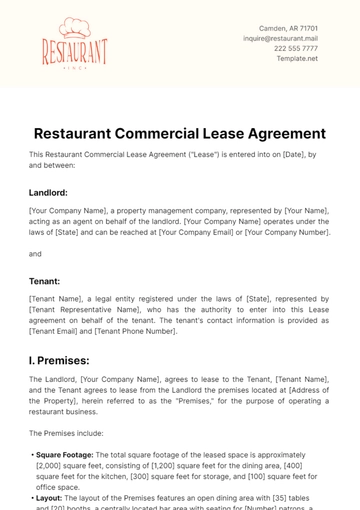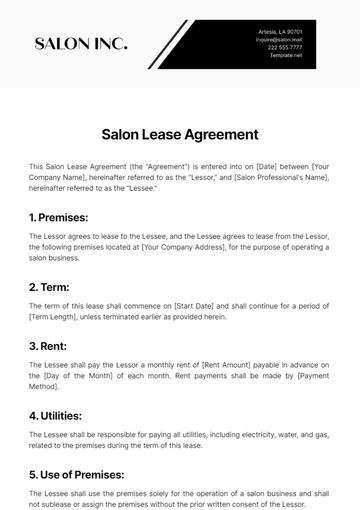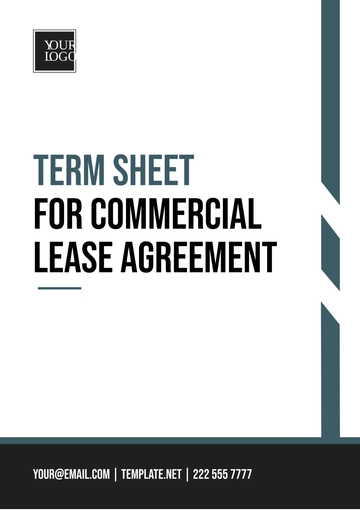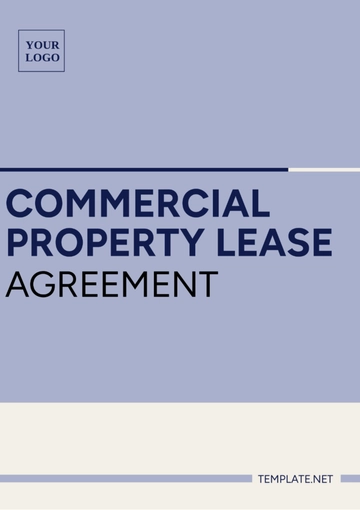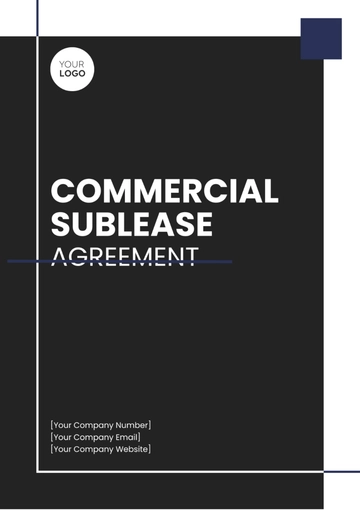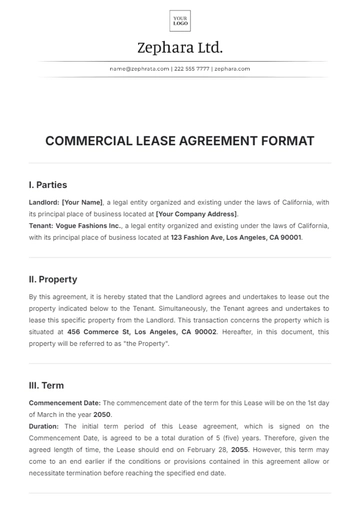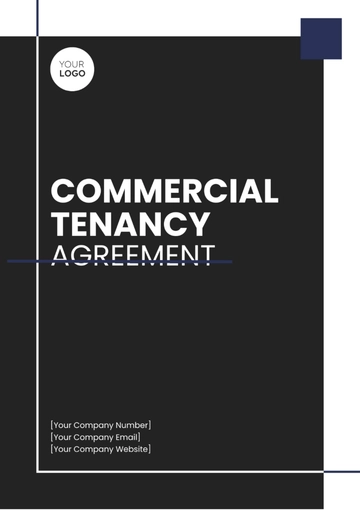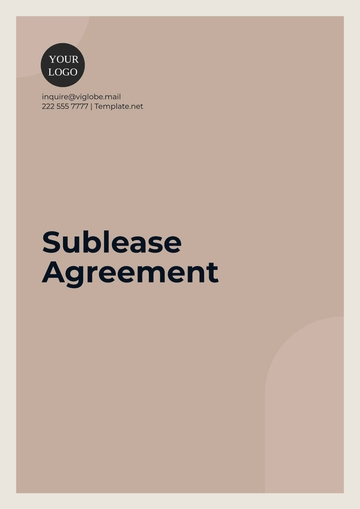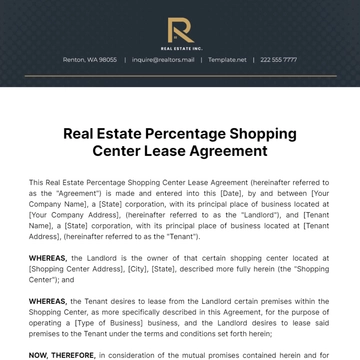Free Movie Theater Lease Agreement Layout%C2%A0Template
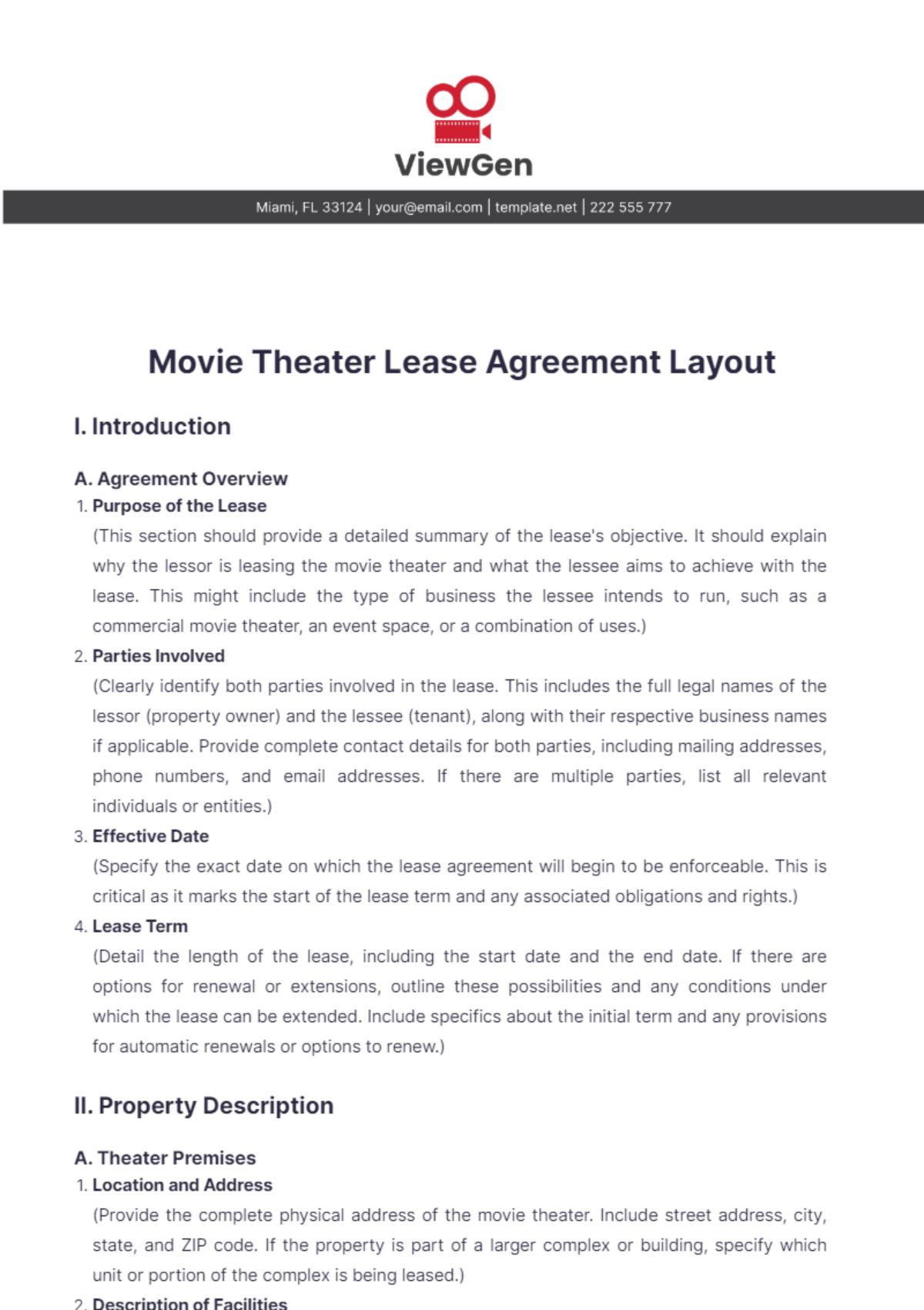
I. Introduction
A. Agreement Overview
Purpose of the Lease
(This section should provide a detailed summary of the lease's objective. It should explain why the lessor is leasing the movie theater and what the lessee aims to achieve with the lease. This might include the type of business the lessee intends to run, such as a commercial movie theater, an event space, or a combination of uses.)
Parties Involved
(Clearly identify both parties involved in the lease. This includes the full legal names of the lessor (property owner) and the lessee (tenant), along with their respective business names if applicable. Provide complete contact details for both parties, including mailing addresses, phone numbers, and email addresses. If there are multiple parties, list all relevant individuals or entities.)
Effective Date
(Specify the exact date on which the lease agreement will begin to be enforceable. This is critical as it marks the start of the lease term and any associated obligations and rights.)
Lease Term
(Detail the length of the lease, including the start date and the end date. If there are options for renewal or extensions, outline these possibilities and any conditions under which the lease can be extended. Include specifics about the initial term and any provisions for automatic renewals or options to renew.)
II. Property Description
A. Theater Premises
Location and Address
(Provide the complete physical address of the movie theater. Include street address, city, state, and ZIP code. If the property is part of a larger complex or building, specify which unit or portion of the complex is being leased.)
Description of Facilities
(Give a comprehensive description of the theater's facilities. This should include details about the screening rooms, size and number of seats, any special features (e.g., IMAX screens, luxury seating), concession stands, restrooms, lobby areas, and any additional spaces such as storage rooms or offices. Highlight any unique features or amenities that are part of the lease.)
Size and Layout
(Provide the total square footage of the leased premises and detail the layout of the theater. This should include the dimensions of the main screening area, the number and configuration of seats, and any other significant spatial arrangements. A floor plan or schematic may be included as an appendix to illustrate the layout.)
III. Lease Terms and Conditions
A. Rent and Payment Terms
Base Rent
(Specify the amount of rent to be paid on a regular basis, whether monthly, quarterly, or annually. Include details on how the rent amount is determined, whether it is fixed or subject to adjustments based on factors such as inflation or market rates.)
Additional Expenses
(Detail any additional costs that are not included in the base rent. This may include utilities (e.g., electricity, water, gas), property taxes, maintenance fees, insurance premiums, and other operational costs. Specify how these expenses will be calculated and billed to the lessee.)
Payment Method
(Describe the acceptable methods for making rent payments. This could include electronic transfers, checks, or other payment systems. Include information on where payments should be sent or deposited and any specific instructions for payment processing.)
Late Fees
(Outline the penalties for late payment of rent. Specify the grace period, if any, before late fees apply, the amount or percentage of the late fee, and any additional charges for repeated late payments.)
B. Security Deposit
Amount
(Specify the amount of the security deposit required from the lessee. This is typically a sum of money held by the lessor to cover potential damages or unpaid rent.)
Conditions for Return
(Detail the conditions under which the security deposit will be returned to the lessee at the end of the lease. This includes stipulations for the condition of the premises upon vacating, any deductions for damages or unpaid obligations, and the timeline for the return of the deposit.)
C. Use of Premises
Permitted Uses
(Clearly define the permitted uses of the movie theater. This should include the primary activities allowed, such as showing films, hosting private events, or operating a cafe or bar. Specify any limitations or restrictions on the types of events or activities that can be conducted.)
Prohibited Uses
(List any uses that are not allowed on the premises. This may include activities that are illegal, hazardous, or incompatible with the intended use of the theater. Prohibitions might also extend to subleasing, making significant alterations, or operating certain types of businesses.)
IV. Maintenance and Repairs
A. Responsibilities
Lessor's Responsibilities
(Detail the maintenance and repair obligations of the lessor. This typically includes maintaining the structural integrity of the building, ensuring that major systems such as HVAC, plumbing, and electrical are in working order, and addressing issues that affect the overall functionality of the theater.)
Lessee's Responsibilities
(Describe the maintenance and repair duties of the lessee. This may include routine cleaning, minor repairs, and upkeep of the theater’s facilities. Specify the lessee’s obligations to maintain the property in good condition and handle any damage caused by their operations.)
B. Alterations
Approval for Alterations
(Specify whether the lessee needs to obtain prior approval from the lessor before making any alterations or improvements to the premises. Include procedures for requesting and obtaining approval, and any criteria that the lessor may use to evaluate proposed changes.)
Restoration
(Detail the requirements for restoring the property to its original condition at the end of the lease. This includes removing any alterations or improvements made by the lessee and repairing any damage that occurred during the lease term.)
V. Insurance and Liability
A. Insurance Requirements
Types of Insurance
(Specify the types of insurance coverage required from the lessee. This typically includes general liability insurance, property insurance, and possibly business interruption insurance. Provide details on minimum coverage amounts and any specific terms or conditions.)
Proof of Insurance
(Outline the requirements for providing proof of insurance to the lessor. This may include providing certificates of insurance or endorsements and updating the lessor on any changes in coverage.)
B. Liability
Indemnification
(Describe the indemnification responsibilities of the lessee. This means the lessee agrees to hold the lessor harmless from any claims, damages, or liabilities arising from the lessee’s use of the premises. Specify any limits to this indemnification.)
Limits of Liability
(Define the limits of liability for both parties. This may include caps on the amount of damages that either party can claim from the other and any exclusions from liability.)
VI. Termination and Renewal
A. Termination
Conditions for Termination
(List the conditions under which either party can terminate the lease early. This may include breaches of the lease agreement, failure to meet obligations, or other significant issues. Include any requirements for providing notice and the procedures for termination.)
Notice Period
(Specify the notice period required for termination by either party. This includes the amount of advance notice needed and the method for delivering such notice.)
B. Renewal
Renewal Options
(Detail any options for renewing the lease at the end of the initial term. This may include options to extend the lease for additional periods, conditions for renewal, and any changes to the lease terms upon renewal.)
Adjustment of Terms
(Specify how the lease terms may be adjusted during renewal periods. This could include changes in rent, modifications to responsibilities, or updates to other lease conditions.)
VII. Legal and Compliance
A. Governing Law
Jurisdiction
(Specify the state or jurisdiction whose laws will govern the lease agreement. This determines which legal system will apply in the event of a dispute.)
B. Dispute Resolution
Mediation and Arbitration
(Outline the procedures for resolving disputes that may arise under the lease agreement. This includes options for mediation and arbitration, and any requirements for engaging in these processes before pursuing legal action.)
C. Compliance with Laws
Local Regulations
(Confirm that the lessee must comply with all local, state, and federal laws and regulations related to the use of the property. This includes health and safety codes, zoning regulations, and other applicable rules.)
VIII. Miscellaneous
A. Entire Agreement
Integration Clause
(State that the lease agreement constitutes the entire agreement between the parties and supersedes any previous agreements or understandings. This ensures that no verbal or written agreements outside the lease are considered part of the contract.)
B. Amendments
Modification Procedures
(Describe the procedures for making amendments to the lease agreement. This typically includes requirements for written documentation and signatures from both parties to validate any changes.)
C. Notices
Method of Delivery
(Specify the acceptable methods for delivering notices between the parties. This may include personal delivery, mail, email, or other agreed-upon methods.)
Addresses for Notices
(Provide the addresses where notices should be sent for both the lessor and lessee. Include details for any alternative addresses or contact persons if applicable.)
D. Signatures
Signature Lines
(Provide spaces for the signatures of both the lessor and lessee, including their printed names, titles (if applicable), and dates of signing. This section formalizes the agreement and confirms that both parties have agreed to the terms outlined.)
- 100% Customizable, free editor
- Access 1 Million+ Templates, photo’s & graphics
- Download or share as a template
- Click and replace photos, graphics, text, backgrounds
- Resize, crop, AI write & more
- Access advanced editor
Secure premises with the Movie Theater Lease Agreement Layout Template on Template.net. This editable tool ensures comprehensive agreements. Use our Ai Editor Tool to outline lease terms, rental conditions, and property use, facilitating clear and professional leasing arrangements for your movie theater.
You may also like
- Lease Agreement
- Non Compete Agreement
- Rental Agreement
- Prenuptial Agreement
- Non Disclosure Agreement
- Operating Agreement
- Hold Harmless Agreement
- LLC Operating Agreement
- Arbitration Agreement
- Purchase Agreement
- Residential Lease Agreement
- Executive Agreement
- Confidentiality Agreement
- Contractor Agreement
- Partnership Agreement
- Postnuptial Agreement
- Collective Bargaining Agreement
- Loan Agreement
- Roommate Agreement
- Commercial Lease Agreement
- Separation Agreement
- Cohabitation Agreement
- Room Rental Agreement
- Child Custody Agreement
- Employee Agreement
- License Agreements
- Settlement Agreement
- Joint Venture Agreement
- Indemnity Agreement
- Subordination Agreement
- Sales Agreement
- Agreements Between Two Parties
- Business Agreement
- Real Estate Agreement
- HR Agreement
- Service Agreement
- Property Agreement
- Agreement Letter
- Restaurant Agreement
- Construction Agreement
- Finance Agreement
- Marketing Agreement
- Payment Agreement
- Investment Agreement
- Management Agreement
- Nonprofit Agreement
- Software Agreement
- Startup Agreement
- Agency Agreement
- Copyright Agreement
- Collaboration Agreement
- Reseller Agreement
- Car Rental Agreement
- Cleaning Services Agreement
- Consultant Agreement
- Deed Agreement
- Car Agreement
- Equipment Agreement
- Shares Agreement
- Data Sharing Agreement
- Advertising Agreement
- School Agreement
- Franchise Agreement
- Event Agreement
- Travel Agency Agreement
- Vehicle Agreement
- Board Resolution Agreement
- Land Agreement
- Binding Agreement
- Tenancy Agreement
- Exclusive Agreement
- Development Agreement
- Assignment Agreement
- Design Agreement
- Equity Agreement
- Mortgage Agreement
- Purchase and Sale Agreement
- Shareholder Agreement
- Vendor Agreement
- Royalty Agreement
- Vehicle Lease Agreement
- Hotel Agreement
- Tenant Agreement
- Artist Agreement
- Commission Agreement
- Consignment Agreement
- Debt Agreement
- Recruitment Agreement
- Training Agreement
- Transfer Agreement
- Apprenticeship Agreement
- IT and Software Agreement
- Referral Agreement
- Resolution Agreement
- Waiver Agreement
- Consent Agreement
- Partner Agreement
- Social Media Agreement
- Customer Agreement
- Credit Agreement
- Supply Agreement
- Agent Agreement
- Brand Agreement
- Law Firm Agreement
- Maintenance Agreement
- Mutual Agreement
- Retail Agreement
- Deposit Agreement
- Land Purchase Agreement
- Nursing Home Agreement
- Supplier Agreement
- Buy Sell Agreement
- Child Support Agreement
- Landlord Agreement
- Payment Plan Agreement
- Release Agreement
- Research Agreement
- Sponsorship Agreement
- Buyout Agreement
- Equipment Rental Agreement
- Farm Agreement
- Manufacturing Agreement
- Strategic Agreement
- Termination of Lease Agreement
- Compliance Agreement
- Family Agreement
- Interior Design Agreement
- Ownership Agreement
- Residential Lease Agreement
- Retainer Agreement
- Trade Agreement
- University Agreement
- Broker Agreement
- Dissolution Agreement
- Funding Agreement
- Hosting Agreement
- Investor Agreement
- Memorandum of Agreement
- Advisory Agreement
- Affiliate Agreement
- Freelancer Agreement
- Grant Agreement
- Master Service Agreement
- Parking Agreement
- Subscription Agreement
- Trust Agreement
- Cancellation Agreement
- Horse Agreement
- Influencer Agreement
- Membership Agreement
- Vacation Rental Agreement
- Wholesale Agreement
- Author Agreement
- Distributor Agreement
- Exchange Agreement
- Food Agreement
- Guarantee Agreement
- Installment Agreement
- Internship Agreement
- Music Agreement
- Severance Agreement
- Software Development Agreement
- Storage Agreement
- Facility Agreement
- Intercompany Agreement
- Lending Agreement
- Lodger Agreement
- Outsourcing Services Agreement
- Usage Agreement
- Assurance Agreement
- Photography Agreement
- Profit Sharing Agreement
- Relationship Agreement
- Rent To Own Agreement
- Repayment Agreement
- Volunteer Agreement
- Co Parenting Agreement
- HVAC Agreement
- Lawn Care Agreement
- SAAS Agreement
- Work from Home Agreement
- Coaching Agreement
- Protection Agreement
- Security Agreement
- Repair Agreement
- Agreements License
